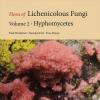
02-12-2024 16:13
 Paul Diederich
Paul Diederich
Flora of Lichenicolous FungiVolume 2 · Hyphomycet

23-12-2024 18:18
Rot BojanHello!I've been working with this small fungus for

21-12-2024 12:45
 Marc Detollenaere
Marc Detollenaere
Dear Forum,On naked wood of Fagus, I found some ha

23-12-2024 12:10
 Bernard CLESSE
Bernard CLESSE
Bonjour à toutes et tous,Pourriez-vous m'aider à

17-12-2024 12:33
 Lothar Krieglsteiner
Lothar Krieglsteiner
this fluffy anamorph was repeatedly found on decid

22-12-2024 10:19
Hello,can anyone help me identify this small ascom

22-12-2024 10:53
 Bernard CLESSE
Bernard CLESSE
Pourriez-vous me confirmer ma détermination de ce
 Flora of Lichenicolous Fungi
Flora of Lichenicolous FungiVolume 2 · Hyphomycetes, 544 pages, 2024
by Paul Diederich, Damien Ertz & Uwe Braun
published by the National Museum of Natural History, Luxembourg
I am happy to announce that the second volume of a world Flora of lichenicolous fungi will be published on 9 December at the National Museum of Natural History in Luxembourg.
Volume 2 focuses on hyphomycetes, a group of asexual fungi in which conidia are not formed within complex conidiomata, such as pycnidia. Most of the species covered belong to the Ascomycota, with a few representatives from the Basidiomycota. In total, 296 species and one variety, across 101 genera, are described, illustrated, and keyed out, with distribution maps provided for most species. Of these, 271 species and one variety are considered obligate lichenicolous fungi, while an additional 25 species are facultatively or doubtfully lichenicolous. This volume introduces four new genera (Gyalectiphila, Llanorella, Pseudophaeoisaria and Stipititheca), 53 new species, 11 new combinations, two new lectotypifications, and 13 new synonymies. Phylogenetic trees are included for genera where reliable molecular data for lichenicolous asexual species are available.
You may order the volume directly at the National Museum of Natural History (https://www.mnhn.lu/science/flora-of-lichenicolous-fungi/?lang=en) at the price of 40 €
or at https://koeltz.com/en/flora-of-the-lichenocolous-fungi-volume-2-hyphomycetes-2024-illus-544-p-gr8vo-paper-bd
For those who don't own the first volume on Basidiomycota, the Museum offers both volumes at a reduced price of 67 €.
I would appreciate if you could forward this announcement to members of national or regional lichenological and mycological societies. Thanks!
I would like to share with you my admiration for this work. Its quality is remarkable. If you haven't got it yet, don't delay. Santa's reindeer are a little more available these days.
Beyond the world of "lichenicologists" of which I am a part, it makes an important contribution to our understanding of the world of hyphomycetes, as demonstrated by the article that closes the Volume: Terminology of hyphomycetes Braun & Diederich.
All the best for the new year,
Alain
PS : My heart goes out to our late Chris, who would have really appreciated this book.

Je partage l'avis d'Alain Gardiennet sur le caractère remarquable de ce livre bien que non lichénologue moi-même.
I fully share Alain Gardiennet's opinion about the remarkable quality of this book though I do not belong to the ''world of lichenologists''
La masse de connaissances mise à notre disposition avec les descriptions, photos macro et micro d'un nombre d'espèces insoupçonné de cet ouvrage qui devrait comprendre 6 volumes à terme, est en effet un cadeau que tout mycologue épris de découvertes peut s'offrir.
The mass of knowledge made available to us, with descriptions, macro and micro photos of an unsuspected number of species in this book, which should eventually comprise 6 volumes, is indeed a gift that any mycologist with a passion for discovery can afford.
Outre Paul Diederich et ses co-auteurs, il nous faut remercier le Muséum d'Hispoire Naturelle du Luxembourg d'assurer cette publication à un prix très correct au regard du travail qu'il représente.
In addition to Paul Diederich and his co-authors, we would like to thank the Luxembourg Museum of Natural History for providing this publication at a very reasonable price for the work involved.
Amitiés
Michel Hairaud
Président d'Ascomycete.org


